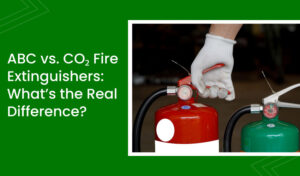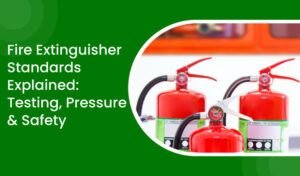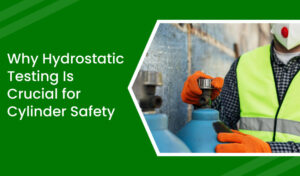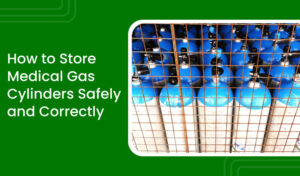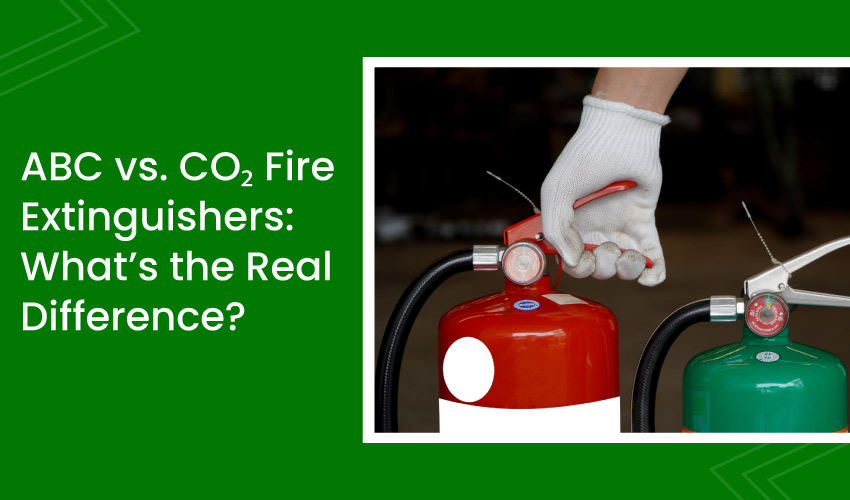
Fire extinguishers are vital safety tools that save life and property in case of a fire situation. ABC and CO₂ fire extinguishers are among the most commonly used, each designed for specific types of fire hazards. Understanding the difference between these two extinguishers is essential for choosing the right one and ensuring effective fire protection in any environment. So, keep reading!
A] What Is an ABC Fire Extinguisher?
The ABC fire extinguisher is a versatile device used to extinguish common fire types found in homes, offices, vehicles, and industrial settings. The word ‘ABC’ denotes different fire types, where ‘A’ stands for Class A fire, which is an ordinary fire that occurs due to the combustion of paper and wood. B denotes Class B fires, which usually occur due to the combustion of flammable liquids, like petrol and oils. And C depicts Class C fires, which typically arise from electrical appliances and are known as electrical fires. The ABC fire extinguisher is used to put out all the fires outlined, eliminating the need for a separate extinguisher for each fire type.
Looking for robust, compliance-ready, and tested across national and international safety standards, fire-fighting cylinders
B] What Is a CO₂ Fire Extinguisher?
A CO₂ fire extinguisher contains a carbon dioxide fire agent ideal for Class B (flammable liquids) and Class C (electrical) fires. Unlike the ABC fire extinguisher, the CO₂ fire extinguisher leaves no residue, making it ideal for electronics, IT rooms, server rooms, and labs. It extinguishes fire by blocking oxygen and dispersing carbon dioxide instead, which cuts off the oxygen that fuels the fire.
C] Key Differences Between ABC and CO₂ Fire Extinguishers
1. Extinguishing Agent & Residue
An ABC fire extinguisher contains dry chemical powder (monoammonium phosphate) that coats and barricades the fire and cuts the oxygen supply, ultimately extinguishing it. It is important to note that this fire extinguisher contains dry chemical powder, which leaves residue behind.
On the other hand, a CO₂ fire extinguisher contains compressed carbon dioxide that puts out the fire by cutting off the oxygen supply. It leaves no residue, as this fire extinguisher contains the CO₂ in a gaseous state, which dissipates into the environment after dispensing.
2. Fire Classes They Tackle
ABC type of fire extinguisher used for extinguishing Class A, Class B, and Class C fires. This versatile firefighter effectively puts out ordinary fires, flammable liquid fires, and electrical fires.
A CO₂ fire extinguisher is used for Class B and Class C fires, where it puts out fires originating from flammable liquids, like petrol, kerosene, and oils. It is not suitable for Class A fires, as carbon dioxide quickly dissipates, making it unusable for fires originating from wood, paper, or cloth.
3. Design and Handling
Due to dry chemical powder, ABC extinguishers are on the heavier side. When it comes to design, they contain a nozzle and a pressure gauge for dispensing and monitoring. They have an easy-handling design, but powder discharge may reduce visibility in enclosed spaces.
CO₂ extinguishers have a horn-like nozzle to prevent the freezing effect due to rapid gas expansion. It provides seamless manoeuvrability due to its lightweight. However, users should be careful while using it, as it releases extreme cold during discharge, which may cause cold burns.
4. Best Use Cases
ABC fire extinguishers are best for multipurpose use, making the ABC fire extinguisher highly versatile. It can be used in homes, schools, offices, and industries. It is highly effective for places where the risk of ordinary, liquid, and electrical fires exists. It is the best option for general fire safety.
CO₂ fire extinguishers are best suited for environments where electrical and electronic equipment is installed, repaired, or manufactured. They leave no residue, making them ideal for extinguishing fires in server rooms, laboratories, workshops, and offices.
5. Safety Considerations
With ABC extinguishers, the dry chemical powder can damage sensitive electronics, create cleanup challenges, and may cause breathing issues in enclosed spaces. Proper ventilation and protective gear are required at the time of use.
Though CO₂ extinguishers dispense clean and residue-free gas, they displace oxygen in the environment, which may cause breathing irritation in enclosed spaces. Proper ventilation and protective gear are required during use.
D] How to Identify and Use Each Extinguisher Properly
To identify and use each extinguisher properly, start by checking the labelling. “ABC” or “CO₂” will be clearly printed on the extinguisher’s cylinder. CO₂ extinguishers have a horn-like nozzle with no pressure gauge, while ABC units contain a standard hose and a pressure gauge. To use any of these, pull the safety pin, aim the nozzle at the base of the fire, squeeze the handle, and sweep from side to side.
Looking for robust, compliance-ready, and tested across national and international safety standards, fire-fighting cylinders
Conclusion
Both ABC and CO₂ fire extinguishers are highly effective firefighting solutions. The ABC fire extinguisher is best for putting out Class A, B, and C fire types, whereas CO₂ extinguishers are an effective option for flammable and liquid fires. Choose the one based on the differences, designs, applications, and most importantly, fire types.
Rama Cylinders is the largest CNG cylinder manufacturer in India. We have sold millions of fire extinguisher cylinders across the globe. Our cylinders are known for meeting national and international quality standards and testing requirements. Contact us today for cost-effective and tailored fire extinguisher cylinders.
FAQs
An ABC fire extinguisher contains dry chemical powder (monoammonium phosphate) and is designed to fight Class A (ordinary combustibles), Class B (flammable liquids), and Class C (electrical) fires.
A CO₂ extinguisher is mainly used for Class B (flammable liquids) and Class C (electrical) fires. It leaves no residue, making it ideal for protecting sensitive equipment, like computers, servers, and lab instruments.
The main difference lies in the extinguishing agent and residue. ABC extinguishers use dry chemical powder, which leaves residue behind, while CO₂ extinguishers release carbon dioxide gas, leaving no residue.
Generally, both ABC and CO₂ fire extinguishers last up to 5–15 years, depending on usage, maintenance, and manufacturer guidelines. Regular inspection and servicing ensure reliability.
Yes, most ABC and CO₂ extinguishers are refillable after use or once they expire. However, refilling should always be done by certified fire safety professionals following safety standards.

